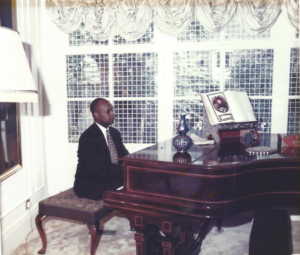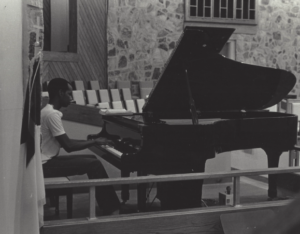
Insights from an executive search professional
By Peter Lawson
As a pianist I have given many performances of compositions by Bach, Mozart, Beethoven, Chopin, Joplin, and other composers, including live performances on National Public Radio and a solo piano recital on the “Live! At the Capitol” concert series. Before performing a composition, I analyze its musical structure including harmony, tonality, rhythm, texture, and form, think about its stylistic elements, and try to understand the composer’s intent. For an orchestra conductor, this process has greater complexity since there are several instruments to be led, directed, managed, and heard. As a management and executive search consultant who also spent many years leading operations, finance, marketing, and strategy for major multinationals, I have been able to draw parallels between the worlds of music and business. Along these lines, I thought it would be interesting and enlightening to look at the orchestra conductor in the context of executive leadership.
When we listen to an orchestra performing large compositions of Mozart, Beethoven, and others, we rarely think about the leadership skills, management skills, analytical skills, and listening skills that a conductor must bring to lead, direct, and unify multiple instruments in these performances. The skills needed to be an effective orchestra conductor have distinct parallels with those needed to be a successful Chief Executive Officer (CEO). Appreciating that these skills have a different hue in musical leadership, there are key takeaways for the executive leader.
Looking at the four skills that are mentioned above: leading, managing, analyzing, and listening, we understand why they are relevant to a conductor who often has to bring 50 or more instruments together in harmony across woodwinds, brass, percussion, and strings. But are there lessons for CEOs and other executive leaders to learn from the orchestra conductor?
Leadership
To lead and guide an orchestra, the conductor must set out and articulate a vision for what he or she would like the orchestra to achieve as a musical outcome. Additionally, in each rehearsal and performance, the conductor must face and engage the musicians, ensure that there is alignment between all sections of the orchestra, and passionately lead them to become one with the music. For each composition, the conductor takes time to learn about the composer and the composer’s inspiration for the music, and spends many hours reading and understanding the musical score which he or she must lead, direct, and coach to achieve a unified sound.
Lesson One – Leadership: Define, refine and clearly articulate a vision. Be visible to all areas of your organization and have regular meetings with your leadership to maintain proper alignment. Ensure that you have a deep understanding of your business and the strategy that you will lead, direct, and coach the organization to execute. Communicate your passion for your brand, your organization, and your people every day and in everything that you do.
Management
The conductor of a large orchestra has to manage several musical personalities, styles of playing, and diverse backgrounds which promote a rich, unique orchestral character. Also, having studied the composition in detail, the conductor actively manages every minute of the orchestra’s performance by remaining engaged with the musicians. He or she has to make sure that all the musicians are aligned in their understanding of the music, playing in the correct tempo and rhythm, following the dynamic markings (indications to play louder or softer), and achieving a sound in line with what can be metaphorically referred to as the “musical vision.”
Lesson Two – Management: Diversity is an asset; leverage it to achieve great outcomes. Capitalize on similarities and differences of individuals in your organization. Create and manage processes that drive multi-functional communication, collaboration, and organizational alignment. Develop, manage, and maintain operating standards and performance metrics. Actively engage your executives, managers, and associates to stay in touch with your business and better manage delivery against the plan.
Analysis
Prior to leading a rehearsal with an orchestra a conductor reads the orchestral score in detail, analyses the music for patterns, voicing, and contrapuntal melodies (two or more different melodies played at the same time), identifies exceptional sections and musical transitions (musical passages linking one section to another), and takes note of passages that may require a particular instrument group or the entire orchestra to pay more attention to detail. In addition, in rehearsals, the conductor may analyze the technique being used by a specific group of instruments if the desired sound is not being achieved and then work with the First Chair (leader for that section) to make the necessary changes.
Lesson Three – Analysis: Devote time to analyzing the business plan/strategic plan, industry and sector reports, economic reports and forecasts, regulatory reports, and competitive and market data so that you are well-equipped to make informed, strategic, data-driven decisions for your organization. Review and analyze the performance of each area of the organization independently and with its leader to understand why that area of the business may be doing well or performing poorly to allow appropriate operational decisions to be made in line with the desired business outcomes.
Listening
Having articulated a vision for the orchestra and its desired sound, the conductor listens to the entire orchestra playing, as well as by instrument group, and in some cases by instrument where passages require solos, duets, or other sub-groups of the orchestra to play a prominent role. The conductor will listen for details in the musical voicing, timbre (color and quality of musical sound), balance of sound, and overall musicality. However, more than anything, the conductor will listen for passion, feeling, and commitment in the performance of the music, which will bring a collective focus on realizing the musical vision for the orchestra.
Lesson Four – Listening: Make the time to actively listen to people in your organization. Absorb, probe, challenge, and respond to them respectfully. Welcome ideas, passionately engage those who share them, and facilitate an environment of sharing, listening, and collaboration with a singular, committed focus on realizing the vision that has been developed, refined, and shared for the organization.
Reflecting on what has been shared above, leadership, management, analysis, and listening are critical skills for the leader of any organization, whether it be a major corporation, small or medium-sized business, orchestra, or sports team. Although these are not the only skills required to successfully lead an organization, they provide a firm foundation and launch pad for other skills, capabilities, and attributes that a CEO, orchestra conductor, or other organizational leader must bring to the role to create an engaged, focused organization that will work positively and cohesively to deliver results.
Director
Tel: 615 371 6113
Mob/Cell: 561 212 0929
E-mail: [email protected]
How Can We Help?
At Stanton Chase, we're more than just an executive search and leadership consulting firm. We're your partner in leadership.
Our approach is different. We believe in customized and personal executive search, executive assessment, board services, succession planning, and leadership onboarding support.
We believe in your potential to achieve greatness and we'll do everything we can to help you get there.
View All Services


